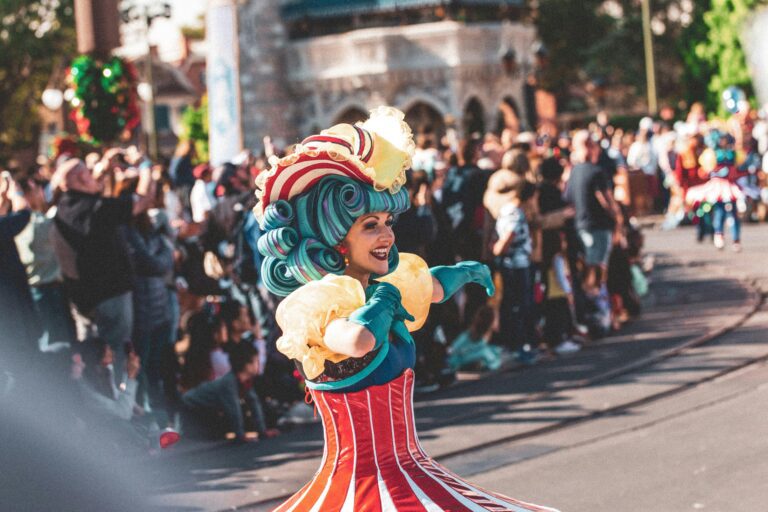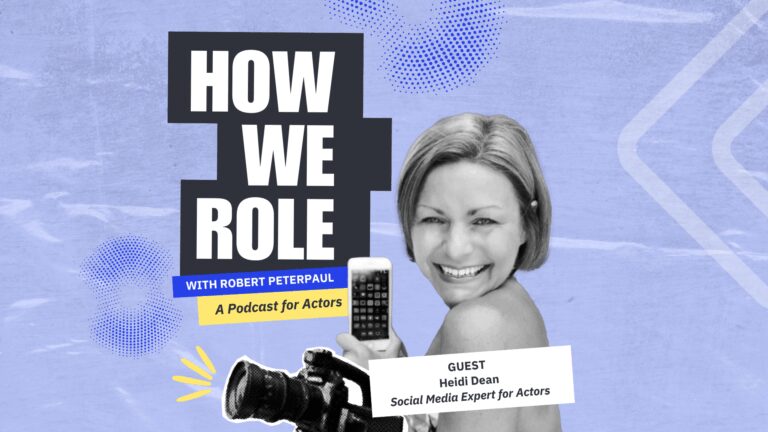Actors often talk about “climbing the ladder.” Still, few realize that there’s an entire professional track outside of traditional stage and screen that not only pays reliably, but also builds the exact skills that major entertainment employers look for.
Theme parks, immersive walkthroughs, brand activations (a marketing strategy to connect a brand with its target audience), touring shows, spring/summer festivals, and character-driven promotional events are no longer side gigs; they’re legitimate training grounds. And for actors with dreams of performing at Disney, Universal, Knott’s Berry Farm, Royal Caribbean, Meow Wolf, Broadway’s experiential activations, and even film/TV character work, these jobs offer one of the most direct routes in.
During the colder season is when you should be thinking about the spring season. As it approaches, parks and festivals start to hire and entertainment vendors staff up. Now is the time to understand how these roles can become an intentional step in your career trajectory.
Let’s break down the strategy: where to start, how to train, how to stay safe, how to manage crowds, and most importantly, how to frame these credits so they elevate your professional brand.
Key Insights
- Spring brings major hiring waves that give actors high-volume, skill-building performance work.
- Activation and park experience develops improv, consistency, and physical performance that casting directors value.
- When framed correctly on a resume, these roles signal professionalism, stamina, and strong guest-interaction skills.
Why Theme Parks & Activations Are a Legit Career Builder (Not “Just Survival Jobs”)
Entertainment has changed. Audiences crave immersive experiences such as world-building, interactivity, character encounters, story-driven spaces, and moments that feel cinematic in real-time. That means parks, festivals and branded events aren’t casual hires anymore; they’re staffed with trained performers, movement specialists, improvisers, puppeteers, singers, hosts, emcees, face characters, and stunt-adjacent actors who can embody roles safely and consistently.
Key reasons these jobs matter for actors:
- Industry-recognized training: Disney, Universal, SeaWorld, Busch Gardens, Six Flags, Kennedy Space Center, and LEGOLAND have formal performer tracks, character programs, and guest-interaction guidelines that are respected across film, TV and live entertainment.
- Repetition = mastery: Thousands of in-character interactions sharpen muscles no class can replicate. You build speed, timing, resilience and consistency.
- Improv under pressure becomes second nature — something casting directors love … and you should, too.
- Professional discipline: Clock-in systems, safety standards, union-style guidelines, choreography calls, and track sheets teach you how to function like a contracted performer.
- Visibility: Hiring managers at major entertainment companies regularly pull from theme parks, cruise lines, brand activations, and seasonal festivals.
- Skill crossover: Stunts, character animation, puppetry, crowd control, hosting and emcee work transfer directly into commercial, voice-over and physical-comedy auditions.
These aren’t “odd jobs.” They’re pipeline jobs that open in springtime.
PART I: How Actors Can Use Spring Hiring Season to Their Advantage
From March to June, nearly every major entertainment venue builds its staff for high season. That includes:
- Theme parks
- Zoos and aquariums
- Historical reenactment villages
- Spring festivals
- Easter/Spring character gigs
- Outdoor walkthroughs
- Resorts
- Spring break promotional events
- Food & wine festivals
- College spring activations
- Corporate brand pop-ups
- Touring events and mobile experiences
Why Spring Is Prime Time for Actors
- Parks expand their entertainment footprint after winter lulls.
- Colleges host massive spring festivals, often with character actors, mascots and interactive hosts.
- Corporate marketing budgets reset, leading to high-demand promotional events.
- Weather-friendly outdoor activations ramp up, and they need actors who can handle crowds and stay in character.
If you want consistent work from April through November, you need to start scanning listings right now.
PART II: Climbing the Ladder — The Strategic Path
This is the actionable, career-building framework many actors don’t realize exists:
Level 1: Local Festivals, Seasonal Events & Brand Activations
This includes:
- Easter bunny performers
- Mascots
- Costumed brand ambassadors
- Food truck festivals
- Spring fairs
- Mall activations
- Museum interactives
- Pop-up events
- Immersive gallery actors
- Character meet-and-greets
Why it matters:
These entry-level gigs give you:
- High-interaction volume
- Character endurance
- Basic improv training
- Familiarity with safety rules
- Comfort in costuming or mascot heads
- Crowd-navigation skills
These credits tell future employers: “I know how to handle people.”
How To List These Credits on Your Resume
“Interactive Performer — Spring Brand Activations (XYZ Agency): Performed 50+ audience-facing sets, maintained character integrity, managed large crowds, executed improv-driven interactions.”
Level 2: Theme Parks & Regional Entertainment Venues
Once you’ve built basics, you can feel comfortable auditioning for:
- Disney
- Universal
- Six Flags
- Cedar Fair parks
- LEGOLAND
- Hersheypark
- Water parks
- Resorts with entertainment
These roles include:
- Character performers
- Puppeteers
- Parade performers
- Hosts
- Singers/dancers in seasonal shows
- Interactive storytellers
- Thrill-ride narrators or themed hosts
- Creature/mask performers
Why this is a major step up:
Theme parks offer structured training that many film directors respect:
- Show tracks
- Vocal safety
- Physical stamina
- Heat safety
- Guest recovery (de-escalation)
- On-the-fly improv
- Precision movement
How To List These Credits On Your Résumé
“Face Character/Interactive Performer — Major Theme Park: Delivered 200+ in-character sets with adherence to brand standards and safety protocols; trained in guest recovery, improv performance, and character animation.”
Level 3: Touring Shows, Cruise Lines & Premium Immersive Experiences
Once you’ve handled park-level consistency, you’re suddenly qualified for:
- Touring kids shows
- National touring experiential activations
- Cruise entertainment (Disney, Royal Caribbean, MSC, Carnival)
- Arena-scale character gigs (Marvel, Nickelodeon, etc.)
- High-end immersive installations
- Museum residencies
- Corporate theatrical experiences
- Hotel immersive performances (Vegas, destination resorts)
These unlock full-time salaries, travel opportunities and exposure to broader creative teams.
Level 4: Film, TV, Commercial, & Motion Capture
Here’s where the “career ladder” actually pays off.
Why do so many film directors love hiring actors with park backgrounds?
Because they can:
- Repeat takes exactly
- Manage costumes/masks/limited vision
- Maintain big physicality
- Handle close-quarters audience or camera work
- Improv on the spot
- Sustain energy
- Take direction quickly
- Handle long days
- Work safely with stunts and children
For motion capture, creature work and commercial mascot/character roles, park actors are often the strongest candidates.
How To List These Credits On Your Resume
“Creature/Character Performance Training (Theme Park Background): Skilled in repeatable physical performance, mask/animatronic operation, safety awareness and on-camera improvisation.”
PART III: Training Every Actor Should Build (Spring Prep Guide)
In order to take advantage of spring season opportunities, start training now. These are the five core areas casting directors evaluate:
1. Improv Under Pressure
Theme parks don’t just want “improv actors;” they want controlled improv actors who are people who can interact safely, stay in character, and handle unpredictable guest behavior.
Training recommendations:
- Take a short-form or kid-friendly improv class
- Practice “reset phrases” that protect character integrity
- Learn how to maintain character in awkward or odd interactions
- Build speed — spring activations often require 15-20 interactions per minute
This becomes crucial for:
- Meet-and-greet characters
- Walkaround roles
- Mascots
- Commercial activations
2. Close-Quarters Audience Interaction Skills
Unlike film acting, which gives you physical separation, live activation work puts people right next to you.
Actors must learn:
- How to keep appropriate distance
- How to angle your body for safety
- How to nonverbally redirect guests
- How to prevent “crowd collapse”
- How to keep line movement going
- How to set personal boundaries through character
This makes you more castable for:
- Theme park characters
- Cruise line entertainers
- Event hosts
- Brand ambassadors
And eventually…
- Multi-cam sitcoms (audience work)
- Live studio performances
- Kids TV hosting
3. Crowd Control & Guest Engagement
Not every actor realizes crowd management is part of the job until they’re placed in a festival, park or promotional environment.
Actors must know how to:
- Guide high-energy crowds
- Handle individuals who dominate interactions
- Use body language to prevent unsafe behavior
- Work with handlers, security and stage managers
- Reset lines efficiently
- Keep energy high while maintaining safety protocols
These skills translate into:
- On-set professionalism
- Production safety awareness
- Leadership roles
- Strong hosting skills
4. Physical Endurance, Heat Safety & Costume Handling
Most spring and summer entertainment roles include:
- Heat
- Long walking tracks
- Heavy or vision-limiting costumes
- Repetitive movement
- Outdoor improvisation
- Quick breaks
Understanding heat illness prevention is basic, yet very important:
- Pre-hydration
- Cooling methods
- Recognizing early symptoms
- Communicating with handlers
- Knowing when to tap out
This directly benefits future stunt, creature and motion capture work, where similar endurance is required.
5. Character Animation & Repeatable Physicality
Actors must make every interaction feel fresh, even if they repeat it hundreds of times in a season.
Learn:
- Repeatable gestures
- Safe exaggerated movement
- Consistency under fatigue
- Character silhouettes
- Movement intention
- Physical storytelling
Directors of commercials, kids shows and costumed TV characters look for exactly this.
PART IV: How to Translate These Roles on a Film/TV Résumé
One of the biggest fears actors have is:
“Will casting directors take theme park or activation work seriously?”
Yes — if you frame it right.
What to emphasize on a résumé:
1. Volume of interactions
Shows stamina, discipline and professional consistency.
- “Performed 300+ character sets during spring season.”
2. Improv fundamentals
Especially if you want commercial, comedy or hosting work.
- “Executed high-volume improv interactions with diverse audiences.”
3. Safety & professionalism
Casting loves actors who understand set protocols.
- “Trained in guest safety, costuming protocols, and emergency procedures.”
4. Physical performance
Perfect for creature, stunt-adjacent and body-based acting.
- “Repeatable full-body character animation in restrictive costumes.”
5. Brand consistency/note-taking ability
Film/TV is full of brand-style guidelines.
- “Maintained brand-mandated character integrity across 500 interactions.”
6. Collaboration with handlers, stage managers and entertainment leads
Tells casting that you play well with others.
You can list theme park and activation roles under “Live Performance” or “Character Performance” sections.
PART V: How to Prepare for Spring Auditions & Submissions
Spring hiring begins as early as January and February. Here’s how to be ready:
1. Update your headshots for character/in-person work
Use shots that show:
- Approachability
- Warmth
- Energy
- Big smile
- Family-friendly look
- Wholesome or playful vibes
Character casting is different from dramatic casting.
2. Build a “Character Interaction Reel”
This is not a traditional acting reel. It should include:
- Quick improv moments
- Reacting to imaginary kids/families
- Warm hosting moments
- Safe, high-energy crowd engagement
- A clip showing quick pivoting
This reel can book festivals, activations and park auditions fast.
3. Get comfortable with movement & choreography
Even “non-dancer” performers need:
- Clean walking patterns
- Simple choreography memory
- Spatial awareness
- Consistency
Take a few beginner movement classes (or even a parade-style conditioning workshop).
4. Prepare for mask/helmet auditions
Practice:
- Gestural storytelling
- Presence
- Clear emotional silhouettes
- Repeatable movement
5. Submit early
Spring jobs hire fast. Agencies often fill roles weeks before the public sees the listing. Check Casting Networks multiple times a day.
PART VI: Safety First — What Actors Must Know (Especially in Spring Crowds)
Spring brings larger crowds that haven’t interacted with performers since winter. Actors must be trained in:
- Heat safety
- Crowd flow patterns
- Exit awareness
- De-escalation
- Communicating with handlers
- Reading guest body language
- When to safely break character
- How to protect themselves without sacrificing performance
This is professional training — and it transfers to:
- On-set intimacy boundaries
- Fight choreography safety
- Working with children
- Navigating large background-crowd scenes
PART VII: The Long Game — How These Jobs Lead to Disney & Big Studios
Many Disney and Universal performers began their careers in gigs just like these. One of the industry’s best-kept “open secrets” is that a considerable portion of today’s Disney and Universal performers didn’t wake up one morning and land a face-character or atmosphere role out of nowhere. They started exactly where most working actors begin: local festivals, mall characters, spring walkarounds, Halloween haunts, brand activations, small theme parks and regional seasonal shows.
Spring seasonal entertainment jobs are one of the smartest paths you can take. These roles are not a detour. They’re a foundation. They sharpen the exact skills that film, TV, commercial and motion-capture directors value most. And they provide a structured way to progress from local activations all the way to world-class entertainment companies.
If you want to build your acting career with intentionality, then start now. Spring hiring is around the corner. Theme parks, festivals and brand activations are waiting. And they’re not just gigs. They’re stepping stones to the career you’ve been trying to build.
Key Takeaways
- Entry-level seasonal gigs can lead to theme parks, touring shows, cruise lines, and eventually film/TV.
- Training now in improv, movement, and character work maximizes spring hiring opportunities.
- Spring roles serve as intentional career steps, not survival jobs, helping actors build long-term momentum.














